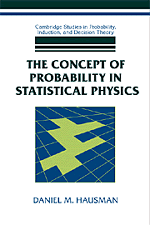Book contents
- Frontmatter
- Contents
- Introduction
- Chapter 1 The Neo-Laplacian Approach to Statistical Mechanics
- Chapter 2 Subjectivism and the Ergodic Approach
- Chapter 3 The Haar Measure
- Chapter 4 Measure and Topology in Statistical Mechanics
- Chapter 5 Three Solutions
- Appendix I Mathematical Preliminaries
- Appendix II On the Foundations of Probability
- Appendix III Probability in Nonequilibrium Statistical Mechanics
- Author Index
- Subject Index
Appendix II - On the Foundations of Probability
Published online by Cambridge University Press: 12 November 2009
- Frontmatter
- Contents
- Introduction
- Chapter 1 The Neo-Laplacian Approach to Statistical Mechanics
- Chapter 2 Subjectivism and the Ergodic Approach
- Chapter 3 The Haar Measure
- Chapter 4 Measure and Topology in Statistical Mechanics
- Chapter 5 Three Solutions
- Appendix I Mathematical Preliminaries
- Appendix II On the Foundations of Probability
- Appendix III Probability in Nonequilibrium Statistical Mechanics
- Author Index
- Subject Index
Summary
FOUR DIFFERENT METHODS FOR INVESTIGATING PROBABILITIES
The classical conceptions of probability emerged in the seventeenth century as byproducts of the discussion on issues related to games of chance. The question that was raised concerned the betting rates appropriate to different gambling situations. At first blush, the question seemed to be solvable by simple calculations. However, when different writers tried to give a comprehensive answer to the question, it became clear that such a solution could be attempted in different ways and that the relation between them was not self-evident.
a. The first type of answer was the following: If you want to inquire into the future results of, for example, the throw of a pair of dice, you should inquire into the physical aspects of the dice-throwing process.
b. Second, it was maintained that a prudent gambler should try to gather information before gambling. For example, before gambling on the future results of tossing a coin, the gambler should toss the same coin a large number of times and use the frequencies of the types of results as empirical data that should enable him to determine his betting rates.
c. Next it was suggested that questions having to do with betting rates could be answered only by introducing special symmetry or invariance assumptions. For example, it was suggested that if we are ignorant with respect to the results of throwing a pair of dice, and if by observing the dice we do not detect any asymmetry, we should be led to believe that all of the possible results are equally likely. Therefore, if there are n possibilities and the prize is 1 dollar, we should be willing to gamble 1/n dollars on any one of the possibilities.
[…]
- Type
- Chapter
- Information
- The Concept of Probability in Statistical Physics , pp. 224 - 244Publisher: Cambridge University PressPrint publication year: 1999

